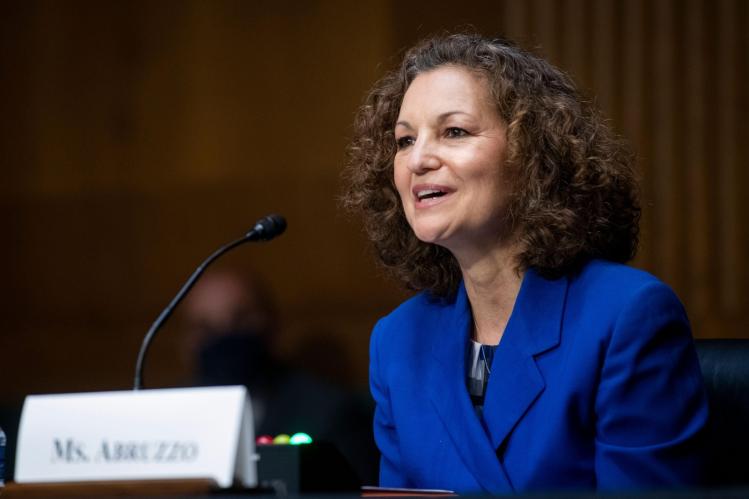
When evaluating the job performance of government officials, I like to apply one of the few sports analogies I understand and consider their “wins above replacement,” a sabermetric term that refers to a baseball player’s record relative to that of the average player with whom their team could replace them. Given who the president is at any particular time, for instance, there may be only so much one can reasonably expect of those selected for certain federal posts; if the bar is low enough, just having key positions filled by those who are not either ludicrously corrupt or actively working against the public interest might be cause for celebration. But when expectations are high, even competent bureaucrats may seem like a disappointment if they fail to truly shine.
With that in mind, one of the star recruits of the Biden administration has been a woman whose name is probably unknown to most Americans, and who rarely, if ever, makes the evening news. Jennifer Abruzzo has served since July 2021 as the general counsel of the National Labor Relations Board (NLRB), the independent agency that administers federal statutes around collective bargaining and unfair labor practices. In her role as the nation’s chief enforcer of labor law, Abruzzo has displayed remarkable creativity in how she has used the power of her office to help ordinary people secure more power in their own places of work.
The NLRB’s general counsel under Donald Trump, Peter Robb, had been on a more or less explicit mission to kneecap the agency, and so virtually anyone that Biden could have selected would have been an improvement. But considering that many of the president’s appointees—especially to agencies charged with overseeing public health, immigration, or foreign affairs—have ended up pursuing policies not very different from those of their predecessors, Abruzzo’s tenacious efforts to advance a pro-worker agenda have been especially impressive. One of her most significant accomplishments to date came this summer, when the Board issued a ruling that some observers have hailed as its most consequential in decades.
The United States has seen a resurgence of union activity in recent years, with major strikes rocking industries from auto manufacturing to health care to TV and film production in the past few months alone. Yet despite the renewed attention paid to organized labor, the fraction of workers who belong to a union remains at or near its historic nadir: according to the U.S. government’s Current Population Survey, as of 2022, just 6 percent of private-sector workers are union members—down from around 25 percent half a century ago, and the lowest figure on record. At the same time, polling has shown that a much larger share of nonunion workers say they would join a union if they could, and that this number has only been growing over time. This naturally raises the question: Why aren’t they?
Part of the explanation has to do with the fact that starting a union in your workplace is not easy, and often becomes even more difficult once your boss catches wind of what you’re up to. Although employers are legally prohibited from interfering with workers’ right to join a union—by, say, threatening to fire them if they do—the penalties for such interference are, in practice, very weak. As MIT economist Anna Stansbury has argued, it should come as no surprise that this sort of illegal behavior is pervasive when there are so rarely any meaningful consequences.
Thanks to Abruzzo and her fellow Biden appointees at the NLRB, however, that might be changing in a big way. In a decision known as Cemex Construction Materials Pacific, LLC, handed down in late August, the Board made a major revision to the rules around how private-sector unions are formed. Typically, unions come into being in one of two ways. With voluntary recognition, a majority of employees in a particular workplace announce their desire to unionize by presenting signed “authorization cards” to their employer, who then willingly agrees to begin contract negotiations. With a certification election, a secret-ballot vote is overseen by officials from the NLRB, usually at the request of would-be union members whose employer has declined to recognize them voluntarily.
The case that led to this decision originated in 2018 when a group of truck drivers employed by Cemex, a Mexican distributor of cement and ready-mix concrete, began an effort to organize a union affiliated with the International Brotherhood of Teamsters. Although close to 60 percent of eligible workers had signed authorization cards, the company refused to recognize the union and the workers moved to petition for an election. This is not at all uncommon: businesses that want to remain “union-free” will often withhold voluntary recognition in order to buy time to dissuade their workers from opting for union representation.
And Cemex really made the most of its extra time. In the run-up to the NLRB vote in early 2019, the corporation spent well over a million dollars on high-priced lawyers and “union avoidance” consultants, and engaged in aggressive tactics to undermine the organizing drive. It fired one driver for her pro-union stance, threatened to fire or freeze the wages of others, and even hired private security guards to intimidate workers outside the polling place on the day of the balloting. As one Teamsters official put it, “The way Cemex conducted itself when its workers sought to organize five years ago was on par with the way elections are undertaken in a tin-pot dictatorship.”
In the end, the drivers voted not to unionize by a narrow margin of 179–166. Their organizing committee filed a complaint with the NLRB alleging that the company’s coercive behavior had created an environment of fear that tainted the outcome of the election. Ordinarily, even when the Board finds that an employer’s bad behavior may have tipped a vote against a union, the prescribed remedy is to order a do-over, with a warning against trying the same thing again. In rare cases, though, the NLRB has concluded that an employer’s conduct was so egregious that a fair rerun of the election would have been effectively impossible. In such instances, the Board has ordered the employer to recognize and bargain with the union without a do-over, provided there was an earlier showing of majority support in the form of signed authorization cards.
In the Cemex case, the Board agreed that management’s antics had likely not only affected the result but also made a fair do-over unworkable, and ordered the company to bargain with the union. But it also established a wholly new algorithm for handling such cases in the future: from now on, if an employer is presented with a request for voluntary recognition from a majority of its workers but insists on an election, there will be no do-overs. If the employer is found to have intimidated workers ahead of a vote, the Board will immediately compel it to bargain.
According to Harvard Law School student Tascha Shahriari-Parsa, this new arrangement has the potential to “significantly dissuade flagrant transgressions of our labor laws—possibly more than any Board decision of the last half-century.” The American Prospect’s Harold Meyerson wrote that, when taken together with other recent Board actions, the Cemex ruling “makes union organizing possible again.” Georgetown Law professor Brishen Rogers thinks that it “may be the most important NLRB decision in a generation.”
Precisely for those reasons, organized capital has denounced the Cemex decision as a radical departure from long-settled precedent, even though the truth is closer to the opposite: the new framework the ruling sets up harks back to an older labor-law principle known as the “Joy Silk doctrine,” which was embraced by the NLRB from the Truman Administration until the mid-1970s. Under Joy Silk, employers could not refuse to voluntarily recognize a union simply because they didn’t feel like it; they could only insist on an election if they had a “good-faith doubt” that a majority of their workforce really wanted one. Labor lawyer Brandon Magner has maintained that the principle’s abandonment “explains much of the chronic under-enforcement of federal labor law over the last half-century” and is a crucial reason why employers are now more brazen in resisting unions than they were in the past.
After taking office, Abruzzo made clear that she intended to ask the Board to revive the Joy Silk doctrine whenever it had an opportunity to do so. Although the Cemex decision does not fully resurrect that earlier precedent, it moves in that direction by effectively declaring that employer intimidation or coercion is evidence of bad-faith doubt that warrants calling off an election. Thanks to Abruzzo’s knowledge of labor-law history—and willingness to support an idea that even most scholars in the field had come to assume was a dead letter—a more effective system of deterrence against union-busting is beginning to take shape.
Some have expressed doubt that the Cemex precedent and other recent actions of the current Board can survive the inevitable onslaught of employer lawsuits. But as Georgetown’s Rogers has also emphasized, “labor and the state can use [Cemex] to change power alignments right now through organizing—which in turn would help it survive review.” Labor-law reforms are no substitute for the difficult task of convincing workers to engage in collective action in their workplaces. But history suggests that tearing down obstacles to organizing can spark a virtuous cycle: as unions become stronger, they can apply more pressure on elected officials to enact other policies that empower workers. Cemex could create an opening that makes it possible to pass other helpful measures, like monetary fines for unfair labor practices of the sort included in the Protecting the Right to Organize (PRO) Act or Build Back Better Act, both of which passed the House of Representatives in 2021 only to die in the Senate.
No matter how capable, civil servants or politicians will not be able to revitalize the labor movement in America on their own. The contributions of committed individuals outside government—academics, journalists, lawyers, organizers, and workers themselves—are needed, too. To return to the baseball analogy, one star player will not be enough: only a real team effort will win the game.
Please email comments to [email protected] and join the conversation on our Facebook page.
Previous Story
Synodality Works
Next Story
A Good Start for the Synod...

